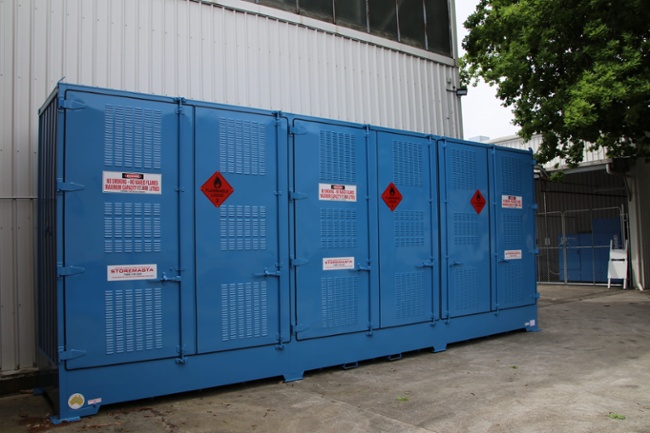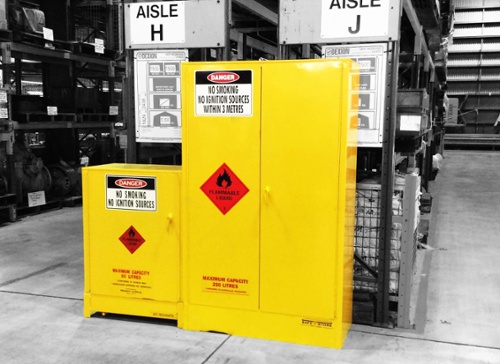Many business owners, managers and supervisors get a little uneasy when they hear the words ‘legislation’ or ‘compliance’. Running a complex operation that requires the use of large quantities of hazardous chemicals or dangerous goods is challenging enough; but add chemical safety compliance and it can suddenly feel totally overwhelming. We break down the essential compliance information that you need to know, including the WHS Regulations, Codes of Practice and the Australian Standard so you can create a safe and compliant workplace if you’re carrying any type of Class 3 Flammable Liquids.
Legislative Framework In Australia
To fulfil your legal requirements and ensure that the way you use, store or handle flammable liquids at your workplace is 100% safe, first you must understand the way work health and safety laws are structured in Australia.
Every state and territory in Australia have a Work Health and Safety Act and a set of Regulations. The WHS Act and Regulations in each jurisdiction are harmonised to a national consistency. What this means is that no matter where you operate in Australia, you must provide the same level of safety protection for your workers and in the workplace generally.
WHS Regulations
The WHS Regulations outline the specific ways that organisations and people with WHS obligations must carry out their duties to keep their workplace safe.
Regulations mandate things like licences, administrative records, warning signs, chemical labels, fire and emergency planning and banned substances. WHS Regulations are issued in each state and territory and are based on the Model WHS Regulations developed by Safe Work Australia.
PLEASE NOTE: Even though we’ve related the content to flammable liquids, you could apply the concepts and requirements of WHS to a hazardous substance in any dangerous goods class.
Understanding the WHS Regulations
There are various ways that WHS Regulations help businesses fulfil their obligations to creating and maintaining a safe workplace.
The WHS Regulations details measures to take to effectively reduce risk in your workplace.
You’re obliged to obtain or undertake the following safety measures:
- Carry out specific actions to reduce risk
- Implement and maintain hazard controls
- Provide adequate administrative procedures
- Obtain certain licences relevant to your workplace
By adhering to these safety measures as outlined in WHS Regulations, your workplace will be able to minimise the risks associated with specific hazards.
PLEASE NOTE: While this post highlights some of the key requirements of the WHS Regulations, it’s no where near the full list. To reduce chemical risk in your workplace, make sure that you always carry out your own risk assessment or engage the services of a qualified Dangerous Goods Consultant.
WHS Act
The Work Health and Safety Act in your state or territory is the foundation of all WHS legislation in Australia. It is based on the Model WHS Act developed by Safe Work Australia. The WHS Act in each state defines the underpinning safety obligations (and duties) of organisations, office holders and individuals in every workplace. Its main obligation — to provide a workplace that is free of risk to workers, other people and the surrounding environment.
Primary Requirements Of The WHS Act
The primary requirements of the WHS Act that apply to flammable liquids are:
Duty Of Care
Every person in the organisation — business owners, directors, managers, supervisors, workers and contractors —has a WHS duty. A WHS duty cannot be transferred to another person.
- Business owners and operators: ensure the health and safety of everyone at the worksite. This includes workers engaged in operations of the business, as well as other persons who may be visiting the premises — or even living on properties nearby.
Eg, The business owner hires a HSE Manager who implements a risk management methodology that systematically identifies, assesses and controls all safety hazards (including the hazards associated with flammable liquids). The HSE Manager co-ordinates a WHS committee and together they develop mechanisms so that each hazard is periodically reviewed and safety compliance is sustained.
- Managers and supervisors: provide training and supervision to their workers, enforce safety policies and keep themselves safe.
Eg, supervisors at the fuel transfer station carry out a pre-shift safety forum every morning before workers commence their duties. Supervisors would breach their duty of care if they allowed a new worker on their first shift to access fuel transfer equipment without proper training and supervision.
- Workers and contractors: follow safety instructions, use safety equipment and keep themselves safe.
Eg, the employer issues chemical goggles and gloves to use while handling flammable liquids. Workers breach their WHS duties if they refuse to wear the PPE without justified reasons.

Duty of Care includes the training and supervision of workers to ensure that safety is maintained onsite.
Safe Work Environment
The WHS Act requires you to provide and maintain a work environment without risks to health and safety. However, we find that many of our customers struggle with this concept — after all, how can you store 2,000 litres of flammable liquids onsite and claim the work environment is free of risks and hazards?
To fulfil your obligations, you will need to minimise the risk far as possible by:
Identifying workplace hazards and assessing the risks they present to workers.
Eg, 2,000 litres of unleaded petrol kept onsite. Petrol is highly flammable and explosive. Petrol is a significant health hazard being carcinogenic, a serious eye and skin irritant and hazardous if inhaled, ingested or swallowed.
Assessing the potential consequences of those risks and the likelihood of them causing a dangerous event.
Eg, 2,000 litres of flammable liquids could cause a catastrophic fire and explosion resulting the deaths of workers, the destruction of property, damage to the local community and natural environment.
Putting measures into place that eliminate the hazard or minimise the level the harm.
Eg, you install a number of outdoor flammable liquids stores and locate them in an isolated location away from ignition sources and vehicles, then restrict access to the area.
Carrying out regular inspections and reviews to monitor existing hazards and identify emerging safety issues.
Eg, you engage independent Dangerous Goods Auditors to carry out monthly inspections on your flammable liquid’s stores, decanting stations and handling areas. The auditor’s report safety breaches and recommend corrective action.

By scheduling regular inspections and reviews, you can effectively reduce risk in work areas that carry Class 3 Flammable Liquids.
Safe Systems Of Work
You have an obligation under the WHS to provide safe systems of work. Safe work procedures also support your responsibility to provide a workplace free of risks and hazards.
Examples of safe systems of work include:
- Having a specific policy that prevents maintenance and welding work from being carried out in areas where flammable liquid storage cabinets and outdoor stores are located.
- Carrying out pre-shift inspections of chemical stores, fuel transfer stations and safety cabinets
- Introducing a visitor registration and monitoring system that restricts access to chemical storage and handling areas.
- Enforcing a buddy system when decanting or transferring larger quantities of flammable liquids.
Safe Use, Handling and Storage of Substances
The WHS Act requires you to have measures in place for safely storing and handling all chemicals and Dangerous Goods. These must be suited to the individual properties of each chemical and take into consideration the quantities held onsite.
Examples of safe storage and handling include:
- Keeping smaller quantities in a dual skinned Class 3 Flammable Liquid storage cabinet that has been manufactured to comply with the Australian Standards.
- Storing large quantities of flammable liquids outside in a dedicated flammable liquids store.
- Installing adjunct safety showers, eyewash units, firefighting equipment and keeping a Register of Hazardous Chemicals.
A compliant flammable cabinet is a risk control measure that will assist your business in achieving chemical risk reduction.
Information Training Supervision
You must provide sufficient training and supervision for your workers to fulfil the requirements of the WHS Act. Training and supervision requirements are covered in detail in the WHS Regulations.
Examples of staff training that relates to flammable liquids include:
- Having a formal induction program for new workers, contractors and site visitors which familiarises them with flammable liquids storage areas.
- On the job training to ensure your workers are aware of the chemical hazards associated with flammable liquids — and know how to keep themselves safe.
- Training on how to use flammable liquids handling and storage equipment in the correct manner.
- Having supervisors enforce safe work practices.
Providing your staff, supervisors and contractors with adequate training is a key consideration for businesses who want to maintain compliance.
Laws Vs WHS Codes of Practice
In Australia, safety laws are underpinned by the WHS Act and Regulations. These two pieces of legislation outline the obligations and responsibilities of each (and every) person who owns, works or interacts at a workplace.
Because the modern workplace is filled with a complex range of risks and hazards, the WHS Regulators in each state and territory issue official Codes of Practice to help organisations meet the requirements of the WHS Act and WHS Regulations.
IMPORTANT: We suggest using Codes of Practice within your risk assessment, but make sure you carry out additional research if the scope is too limited for your operations.
While Codes of Practice outline specific issues, it is beyond their scope to cover every risk or hazard that could arise in a workplace that carries Class 3 Flammable Liquids. While you should always use Codes of Practice as the basis of your risk assessment, you may also need to carry out further research if their scope is limited.
REMEMBER: Codes of Practice that are approved under section 274 of the WHS Act, can be used as evidence during court proceedings to demonstrate whether WHS laws have been met. Plus, they can be referred to by a WHS Inspector when issuing a prohibition or improvement notice.
Do I Have to Comply with a Code of Practice?
The answer to this question is ‘Yes, and no.’ You must comply with the requirements of a relevant Code of Practice unless you can find another method which provides the same (or higher) level of safety protection.
As we mentioned earlier in the blog, it’s not possible for a Code of Practice to cover every single hazard you might encounter on a job site. Chemical hazards, and your capacity to implement control measures, can vary due to regional considerations — such as location, climate, site access, supply availability, cultural and indigenous issues, as well as state and local government restrictions.
The chemical quantities that you have onsite as well as any environmental impacts will also influence how you control chemical hazards in your specific workplace.
Model Code of Practice
Managing Risks of Hazardous Chemicals in the Workplace is a Model Code of Practice that’s essential reading for anyone who carries hazardous chemicals at the worksite.
The code covers a range of health and safety issues including hazardous chemical registers, chemical labelling, safety data sheets (SDS), workplace exposure standards, health monitoring, emergency plans and ways to control risk.
Managing Risks of Hazardous Chemicals in the Workplace walks you through the full requirements of the WHS Regulations and provides specific advice including:
- Applying the risk management process to hazardous chemicals.
- Relevant sections of the WHS Regulations and how they apply to chemicals.
- Suggested control measures and best practices for specific chemical hazards including flammable liquids.
- Suggested resources for further hazard research.
Other Relevant Codes of Practice
There are several Model Codes of Practice that provide guidance on controlling the hazards associated with flammable liquids. These codes are approved under section 274 of the WHS Act in most states and territories.
The Model Codes of Practice include:
Labelling of Workplace Hazardous Chemicals
Use this Code of Practice to better understand your responsibilities to ensure chemical containers are correctly labelled.
Spray Painting and Powder Coating
Use this Code of Practice to find safer work methods and reduce chemical exposure and fire risk.
First Aid in the Workplace
The important code details how to determine first aid requirements, provide equipment, facilities and training, and explains the risk management process when it comes to first aid in the workplace.
Managing the Work Environment and Facilities
This code provides the essential requirements for ensuring the physical aspects of your workplace are safe and properly ventilated, with guidelines for lighting, heat and cold, air quality and workstations.
The Requirements of the Australian Standards
For even more detailed guidance on how to handle and store Class 3 Flammable Liquids, turn to the Australian Standards.
The Australian Standards provide an industry-recognised set of requirements that can assist businesses in achieving chemical compliance in their workplaces. Their primary purpose is to ensure the world’s products, services, systems, and workplaces are safe, effective, consistent and reliable.
While Standards are technically voluntary, they may be referred to by a State or Government authority. When this happens, the Standard is mandated under legislation. An example of this is that workplace exposure standards are considered mandatory under the Work Health and Safety (WHS) Regulations.
Referring to AS 1940
When carrying any dangerous goods, such as Class 3 Flammable Liquids, we recommend complying with Australian Standards. This is because these documents provide known risk control strategies that are recognised by WHS Regulators and other government agencies.
AS 1940 FREE download for safe indoor storage
To put it another way, if you don’t comply with the safety requirements that are detailed in the Australian Standards — and you had a critical incident at your workplace — could you present a legitimate reason in court for ignoring their guidelines?
Standards That Guide Flammable Liquids Compliance
When your organisation is carrying Class 3 Flammable Liquids, it’s best practice to refer to the requirements of the Australian Standards. The Standard which explains the safety requirements for flammable liquids is: AS 1940 – The storage and handling of flammable and combustible liquids.
The Standard should be used during the risk assessment process (along with the WHS Regulations and relevant Codes of Practice). AS 1940 provides specific details for a range of chemical compliance matters.
These requirements for flammable liquids handling and storage include:
- General requirements - including design and construction requirements, lighting, firewalls and vapour barriers, security, ignition sources, signs and notices
- Minor storage – including minor storage quantities, precautions and minor storage in tanks
- Packing storage and handling areas – including types of stores, location and separation distances, construction, ventilation and activities within package stores
- Storage in tanks – including venting, location and capacity of indoor tanks, bunds and compounds
- Fuel dispensing – including, dispensers, delivery hoses and nozzles, operations
- Tank vehicle loading facilities – including top-filling installations and bottom-loading facilities
- Operational and personnel safety – including placarding, liquid transfer, effluent control, personnel training, records, PPE, first aid and bulk transfer
- Emergency management – including planning for emergencies, manifest and placarding
- Fire protection – including fire protection equipment, portable fire extinguishers, fire protection requirements, piping and pumping systems
- Waste storage and disposal – including storage of wastes, waste management, waste disposal and methods of disposal
IMPORTANT: When you’re storing flammable liquids at your workplace, the requirements of AS 1940 will provide you with a detailed set of control measures so you can reduce your risk. It’s important to ensure that your flammable liquids cabinets and stores are constructed, installed, set-up and maintained to meet the specific requirements of the Australian Standard.
Workplace Exposure Standards
Safe Work Australia developed the workplace exposure standards to assist in the management of health and safety in workers.
Hazardous chemicals, such as flammable liquids, release harmful contaminants into the air and breathing zones of workers. These contaminants, whether they’re vapours, mists, fumes or dusts, can be harmful if inhaled or ingested by workers.
Complying with the workplace exposure standards is not only recommended — it’s the law.
Workplace exposure standards set the acceptable chemical concentration levels within the breathing zones of workers (and other onsite personnel). You should check the safety data sheet of each of your flammable liquids to determine if that chemical has a workplace exposure standard. If it is included in the list, compliance is mandatory.
REMEMBER: Workplace exposure standards are referenced in Australian WHS Regulations. This means that your workplace must adhere to the guidelines set out in the workplace exposure standards for each hazardous chemical that you have onsite.
Other Relevant Standards
Handling and storing any class of dangerous goods is challenging, so it’s ideal to take a site-by-site approach to risk management. You must also remember to refer to other relevant standards which can assist in providing chemical compliance for your organisation.
When carrying any type of Class 3 Flammable Liquids, we always recommend cross-referencing other Australian Standards. This should be based on the quantities of flammable liquids that you’re carrying, what types of container types (ie. IBCs) that you’re using, if you have other classes of dangerous goods onsite and whether your flammable liquids stores require mechanical ventilation.
There are several other Australian Standards that can assist your business in taking the steps towards flammable liquids compliance.
If you’re working with several classes of dangerous goods, you must refer to the Standard that relates to each chemical class. These Standards will detail all handling and storage requirements for your class of dangerous goods — including segregation from incompatible substances.
IMPORTANT: When there are mixed classes of dangerous goods onsite, there are increased risks with handling and storage, so all safety requirements should be followed.
We also recommend referring to the following Standards to assist in flammable liquids and dangerous goods safety:
AS3833 — The storage and handling of mixed classes of dangerous goods, in packages and intermediate bulk containers
If you store any type of chemicals in packages or IBCs, we recommend following AS 3833. Apart from detailing chemical incompatibilities and segregation distances, this Standard provides essential warehouse, storage, housekeeping, ventilation, waste disposal, and spill management practices.
AS 4775 — Emergency eyewash and shower equipment
If a risk assessment indicates there is a risk of physical injury from flammable liquids, you may need to install emergency eyewash and shower equipment within 2-10 metres of your safety cabinets. AS 4775 outlines the minimum specifications for each piece of equipment, as well as installation, post-installation testing and ongoing maintenance.
AS 16682 – The use of ventilation and airconditioning in buildings
As we’ve highlighted earlier in this blog, it’s crucial that your flammable liquids (and other dangerous goods) don’t exceed the workplace exposure standards for airborne contaminants. If your indoor stores do require mechanical ventilation systems, the system must comply with the requirements of this standard.
Further Guidance Materials for Flammable Liquids Compliance and Safety
There are literally thousands of places online to source quality guidance materials to assist with Class 3 Flammable Liquids safety for your workplace.
Examples of these guidance materials for flammable liquids compliance include:
WHS Regulators
One of the first places you should look for guidance notes and materials is the work health and safety regulator in your state or territory.
Browse and search your local WHS Regulator’s website using the term ‘flammable liquids’ to find guidance materials that refer to flammable liquids compliance in your state or territory.
Here’s just a few examples of the resources that are available online:
- SafeWork New South Wales - Flammable substances; Storage and handling of dangerous goods; Hazardous chemicals; Hazardous chemicals notifications
- WorkSafe ACT – Hazardous chemicals; Dangerous Substances Information; Checklist 018 Hazard Identification Checklist
- WorkSafe Victoria - Guidance note: Spraying of flammable liquids; Filling portable fuel containers with flammable liquids at service station
- WorkSafe Queensland - Flammable and combustible liquids; A guide for flammable and combustible liquids; Hazardous areas; hazardous area classification (fire and explosion prevention)
- SafeWork South Australia – Flammable liquid storage and transport; Hand sanitiser; Hazardous chemicals; Chemicals & substances
- WorkSafe Western Australia – Flammable liquids – A burning issue; Hot work – fire safety essentials; Gases, vapours, smoke and fumes
- WorkSafe Northern Territory – Hazardous chemicals placard and manifest quantities; Hazardous chemicals notifications; Dangerous Goods; Hazardous chemicals
- WorkSafe Tasmania – Hazardous chemicals; Hazardous chemicals safety
Chemical Manufacturers and Suppliers
When carrying any type of dangerous goods, you should always refer to the safety data sheets (SDS) of the individual hazardous chemical product.
The SDSs will give you exact details on the chemical’s hazards as well as the guidelines for storage, handling and emergency procedures.

Make sure you refer to the SDS of your flammable liquids to ensure that they’re being stored in a safe and compliant manner.
If you require further information about the chemicals that you’re using, you can also contact the manufacturer. They will be able to provide you with specific advice. This is particularly helpful if your workplace uses very large quantities of chemicals or you require flammable liquids for specific production purposes.
Industry Associations
The industry or employment sector your workplace falls under will have at least one industry association. Industry associations in mining, construction, earthmoving and transport usually produce their own range of guides to improve safety and address common hazards.
Some examples include the following Australian associations:
- AMEC – Association of Mining and Exploration Companies
- ACA – Australian Constructors Association
- ALRTA - Australian Trucking Association
- NatRoad – National Road Transport Association
Need Assistance with Flammable Liquids Compliance?
Being able to access the correct resources — in addition to the WHS Regulations and the Australian Standards — is an important step to becoming flammable liquids compliant. The risks association with flammable liquids are significant and can include dangerous incidences such as workplace fires, devastating explosions, human harm and environmental damage.
Did you know that not fully identifying a chemical hazard is one of the key causal factors behind incidents involving fuels and flammable liquids? To find out more about how a fully compliant Class 3 Flammable Liquids cabinet can significantly minimise chemical risk, please download our popular eBook Essential Considerations When Storing Flammable Liquids Indoors. Take the next step in fire and chemical safety and access your free copy today.
Joining the team as a Dangerous Goods Storage Consultant, Melissa Hampton became Storemasta's Marketing Manager in late 2021. With extensive knowledge and experience in chemical compliance, Melissa is responsible for leading the Marketing team and helping shape their marketing strategy. In her spare time, you can find Melissa hiking, swimming and enjoying the great outdoors in beautiful north-west Tasmania.

